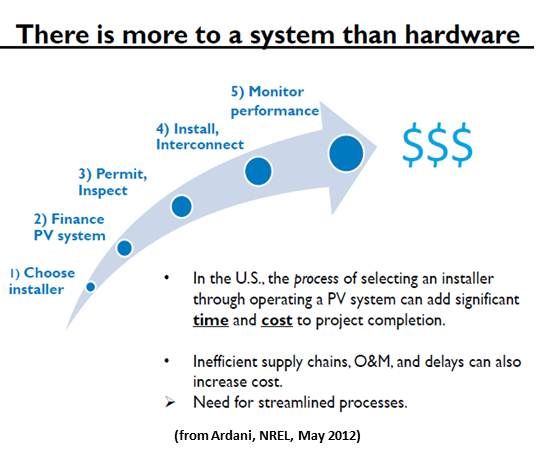With its platform now channeling $2 million per day to credit applications for U.S. PV solar systems, Clean Power Finance (CPF) is working to better the proposition for installers by bringing down their single biggest as yet uncontrolled cost: non-hardware soft costs.
CPF was founded in 2007 as an online tool to connect solar buyers and sellers and to help them design solar systems. In 2011, CPF stepped up its backing of solar by channeling third-party funding from institutional investors to installers of residential PV. It is now the fourth biggest player in the third-party ownership (TPO) space.
The last two years’ unprecedented expansion in PV solar has been driven by the growing availability of third-party capital just as panel prices plunged.
Through TPO, institutional money purchases solar systems, which users lease. The users get a 10 percent to 20 percent utility bill discount with low or no upfront cost and no ownership responsibility. The funder gets the 30 percent federal investment tax credit, the depreciation deduction, and part, or all, of the lease payment revenue stream. The installer gets the work.
Sunrun, SolarCity, SunPower (NASDAQ: SPWR), and CPF are the biggest TPO facilitators. They may get a piece of the revenue stream or a fee. And, though no TPO player has yet done so, they may soon begin earning a new revenue stream by securitizing the lease payment cash flow.
The significant potential threat to the TPO-driven solar expansion is if panel and other hardware prices go up and installer costs don’t come down.
Solar manufacturers are working to keep panel costs down, despite the tariff recently imposed by the U.S. on Chinese imports. TPO facilitators are aiming at balance-of-system (BOS) and soft costs.

Despite the cost of capital it adds, TPO is also a major benefit to installers, according to CPF Director of Government Programs Management James Tong.
“Third-party financing does add a cost because it's an additional service,” Tong said. “We estimate it’s 40 cents to 50 cents per watt, depending on system size and finance terms.”
But, he explained, “if you do an analysis of third-party-owned systems versus cash systems, with CSI data, you will find the cost of a TPO system is lower.”
Getting utility bill savings with no upfront costs or ownership responsibilities, Tong said, “makes the value proposition to the consumer much more appealing.” Selling that proposition, Tong said, “generates more sales. Companies that don't have financing spend more on those acquisition costs, one of the biggest of soft costs.” With financing available, Tong said, installers convert leads to sales faster, make more sales, and generate more and better referrals. That lowers both marketing and sales force costs.
Increasing the volume and flow of sales reduces inventory holding costs such as equipment depreciation, warehousing, and the opportunities lost because money is being spent on those things instead of being invested in growing solar.
Labor is another high cost for installers that financing helps with, Tong said. “Solar is very seasonal. At peak times, employees are working overtime. At dead times, employees do nothing. With consistent volume, cost can be significantly lower.”
“Third-party financing opens the door to thousands of customers that otherwise would not consider solar due to their fear of writing a large check,” said Senior Vice President Todd Lindstrom of Paramount Solar.
But not all installers have adjusted to TPO. California Sun Systems President Tad Rose called it “a mixed bag.”
LA Solar Systems owner Shawn Alvandi, who has been installing solar since 2004, complained that it makes his work more complicated and that dealing with leasing companies puts greater restrictions on him. He has found it easier to sell a buyer on spending “$3,000 to $4,000 more if they have no monthly payments,” he said.

Total average soft costs for installers leave them “a little less than a 10 percent margin, if they are profitable at all.” Their acquisition costs “may be 60 cents to 70 cents per watt or more,” Tong said. “But big companies with financing can keep those costs as low as 25 cents to 35 cents per watt.” According to the most recent CSI data, Tong said, “TPO-financed deals have a lower cost per watt. I'm almost sure that is coming out of acquisition costs.”
The best way to increase the use of solar, Tong said, is to drive down cost. The Clean Power Finance model, he said, is “trading off on margin, but we'll help you get more sales. If we get enough volume, we grow.”
But not all installers see the benefits yet.
Alvandi said he is facing lower margins but no greater volume. “It is still tough to find clients,” he said.
“The third-party offering is crucial,” Paramount Solar’s Lindstrom said. “Otherwise, the pool of potential clients is limited to those that have a tax appetite, the ability to comprehend how that works, and access to cash. With third-party financing, access to cash is simple, straightforward and immediate.”
Rose said he has only seen the TPO option close a reluctant customer “in a couple of instances.”
Paramount Solar started as “a small group of five or six folks three years ago,” Lindstrom remembered. Now it is rapidly approaching 100 employees. Without third-party financing, “we would be a mom-and-pop solar company with twenty employees, tops.”



